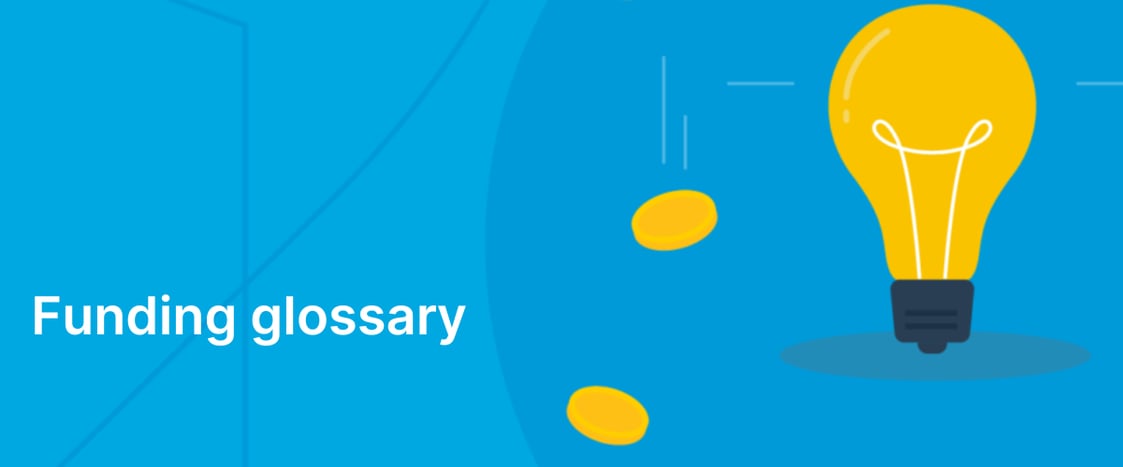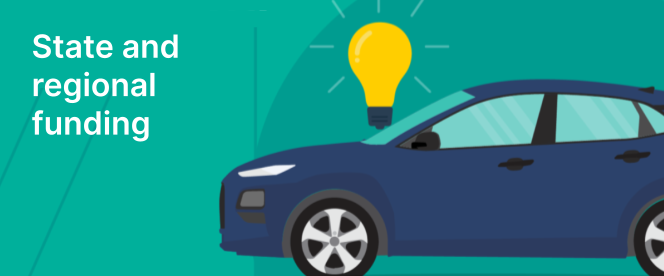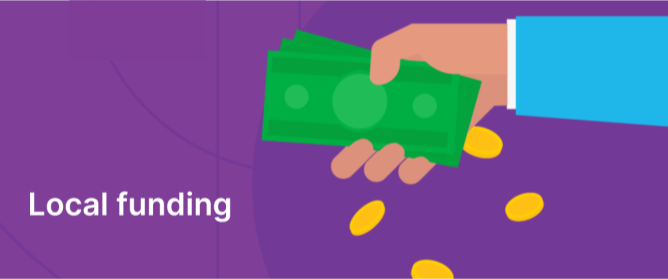Today, there are hundreds of microtransit deployments across the United States, as communities look to expand the reach of public transit and affordably connect more people to jobs, schools, and healthcare. In some places, microtransit provides access across entire cities, like Arlington, Texas, and Wilson, North Carolina. Elsewhere, microtransit supplements existing transit networks, such as in Seattle and Jersey City. However, finding funding tends to be the biggest hurdle a community faces when trying to launch an on-demand transit program, no matter its size or scope.
- Want to back up and learn more about on-demand microtransit? Click here
- Want to dig deeper and learn how microtransit can save agencies money? Click here
Below, we’ve provided an in-depth guide to microtransit funding in the United States, and a handy table of contents to help you skip to our deep dives on federal, state and regional, and local funding options.
- Funding microtransit: an overview and glossary
- Tapping into federal funding to power microtransit
- How state and regional funding comes into play
- Getting local: funding microtransit with ballot measures, partnerships, and congestion pricing
Funding microtransit: an overview and glossary
As with other forms of public transportation, microtransit is funded through a combination of federal, state, and local funding sources, with the exact mix varying widely across communities depending on a number of factors. For example, one of Via’s partners funds its service almost entirely through local funds, while another partner does it through a healthy mix of federal (40%) and local (60%) funds. Officials looking to launch new microtransit services or expand existing services should consider the specific funding sources available to them, based on the nature of the service and relevant state and regional programs. Before we provide guidance on available funding for microtransit, here are a few background notes to keep in mind when assessing funding sources:
Formula vs. competitive funding programs
Transportation funding programs are largely distributed either on a formula or competitive basis. Formula funds are allocated in a predictable manner to recipients every year, while competitive grants are awarded only to some applicants based on a set of criteria. In general, formula funds can provide stable, year-over-year funds to sustain services in the long run. Formula funds typically can be used to fund microtransit (and of course are also used to fund other forms of public transit). Competitive funds can provide funding for new services, expansions, or innovative pilot deployments. However, they require putting together a compelling application and, by nature, they only provide funds for a limited period of time.
Capital vs. operating expenses
Funding programs often make a distinction between capital and operating expenses. Capital expenses are those related to fixed assets, such as vehicles, infrastructure, and software; while operating expenses are variable costs associated with service, such as fuel and driver pay. In general, federal and state funding programs, especially competitive grants, fund capital expenses more fully than operating expenses. However, in some cases, policies allow for capital funds to be used for operating expenses in some circumstances (such as the federal capital cost of contracting rule described below).
Infrastructure Investment and Jobs Act (IIJA)
In 2021, Congress passed the Infrastructure Investment and Jobs Act (IIJA) providing $109B in transit funding, a 79% increase in annual funding over previous years. The Federal Transit Administration’s core formula funding programs received a boost of $8B per year and created multiple new grant programs.
The opening weeks of the Trump Administration have raised a lot of questions about government funding across the board, including programs passed as part of the IIJA. However, we have not seen any specific guidance from the Trump Administration on DOT programs. Additionally, Secretary Duffy has clarified that no previously awarded grants will be impacted by the new administration’s policies. In order to see the policy direction of the Trump Administration regarding DOT grant programs, we’ll need to wait on the release of Notice of Funding Opportunities or additional DOT guidance. Until then, we’ll go into more detail on the IIJA programs in the next section.
Tapping into federal funding to power microtransit
Federal formula funds
Both the Federal Transit Administration (FTA) and the Federal Highways Administration (FHWA) provide formula funds through a number of programs that agencies and cities are using today to run microtransit services. The most notable FTA programs are the Urbanized Area Formula Grants (5307) and Rural Area Formula Grants (5311) programs, both of which were significantly boosted by additional funding in the IIJA. The 5307 program awards funds to transit operators in Census-designated urbanized areas. In large urbanized areas (>200k population), these funds flow directly to designated operators; in smaller urbanized areas, funds flow to the state and then to subrecipients. The 5311 program awards funds to states to fund public transit in rural areas; unlike the 5307 program, funds are not allocated to specific areas but may be spent in any rural areas in the state.
In addition to these two programs, the FTA also provides formula funding for projects serving seniors and individuals with disabilities through the 5310 program, funds for tribal transit under the Tribal Transit Formula Grants program, and funds for capital assistance through the Bus and Bus Facilities (5339) program.
| Program | Purpose | Purpose |
| 5307 | Transit in urban areas | States and transit agencies |
| 5311 | Transit in rural & tribal areas | States |
| 5310 | Transit for seniors & people with disabilities | States and transit agencies |
| 5339 | Capital assistance for vehicles and facilities | States and transit agencies |
FTA formula funding and microtransit
The FTA allows the use of formula funds to cover microtransit. Unfortunately, many cities and smaller transit agencies don’t receive formula funds. But for those transit agencies that do, formula funds are a great resource for microtransit projects.
In general, FTA formula funds will cover 80% of capital costs, including vehicles and software licenses necessary for microtransit services. In addition, most recipients can cover 50% of operating costs with formula funds, except transit agencies serving urbanized areas with a population greater than 200k, which cannot cover operating expenses with federal funds at all. Many transit agencies deploy microtransit by contracting with a private provider to operate the whole service — what some call a “turnkey” solution or “transportation as a service (TaaS).” In this arrangement, agencies can apply the FTA’s “capital cost of contracting” policy. This policy allows half of a turnkey contract to be considered a capital expense.
That means that for urbanized areas with a population over 200k, that policy allows them to receive up to 80% match for half of a turnkey contract’s cost — in other words, 40% of the overall contract. Small urban and rural communities can get that same 80% match on half the contract plus a 50% match on the other half of the contract which is considered operational costs; in other words (we’ll do the math for you!), small urban and rural communities can have 65% of their overall turnkey contract covered by federal formula funds.
FHWA formula funding and microtransit
In addition to FTA programs, the Federal Highways Administration (FHWA) offers two formula funding programs which can support microtransit: the Congestion Mitigation and Air Quality (CMAQ) program and the new Carbon Reduction Program (CRP). CMAQ provides funds to states for transportation projects that reduce traffic congestion or improve air quality, including microtransit. Projects must be located in counties designated “nonattainment” or “maintenance” under certain pollutant standards, except if a state has no such counties, in which case they may be spent anywhere. CMAQ funds generally flow to state DOTs and MPOs. While these funds are awarded on a formula basis, DOTs and MPOs may choose to subgrant them through a competitive process. CMAQ funds may be used for both capital and operating expenses. To access CMAQ funds, please contact your local MPO or state DOT to learn more about how this program operates in your area.
The Carbon Reduction Program (CRP) is a new $6 billion formula funding stream created by the Infrastructure Investment and Jobs Act (IIJA), also known as the Bipartisan Infrastructure Law. CRP provides funds for a variety of projects which reduce carbon emissions, including “on-demand transportation service technologies” such as microtransit. These funds flow to states, but are specifically allocated to certain areas and must be spent in coordination with MPOs. Like CMAQ, CRP funds may be used for both capital and operating expenses, and operators seeking these funds for microtransit should consult their local MPO or state DOT. We have a detailed blog post on this program if you would like more information. Given the focus of CRP on reducing carbon emissions, this program could be impacted by the Trump Administration’s move away from climate-focused programs. However, the Administration has yet to comment on this program specifically.
Federal competitive grants
Unlike formula funds, competitive grants are not guaranteed to specific areas or recipients and must be applied for. In general, competitive grants fund projects that advance policy objectives such as sustainability, innovation, or equity. Via has partnered with a number of cities and transit agencies on successful grant applications to launch new or expanded microtransit services.
A number of new and updated federal grant programs in the IIJA provide funding for microtransit as an eligible expense including:
- Advanced Technology and Innovation (ATTAIN): The FHWA’s ATTAIN program (previously known as ATCMTD) provides capital and operating assistance for projects that deploy innovative technologies in public transportation, including microtransit services. ATTAIN is particularly suited for highly innovative projects; in October 2024, Via worked with Lane Transit District in Oregon on a successful application for a $5.2 million grant to develop an on-demand microtransit pilot program within the Bethel School District boundary. This program intends to increase student transportation options so that they have better access to community activities and social services.
- Congestion Relief Program The upcoming Congestion Relief Program provides grants of $10 million or more for projects which reduce traffic congestion in urbanized areas with a population greater than 1 million. In the law, “on-demand microtransit” is specifically listed as an eligible activity. Many cities have been anxiously awaiting the first round of this program which is expected to open later this year.
- Rural Surface Transportation Program The USDOT’s Rural Surface Transportation program provides grants for projects in rural areas (defined as all areas except urbanized areas with a population greater than 50,000) for public transportation projects, including microtransit. The program provides capital assistance, but recipients can invoke the capital cost of contracting provision explained above to cover the cost of a turnkey or service contract. Last year, the North Carolina Department of Transportation was awarded $10.4 million to fund microtransit services in 11 communities across the state. The Notice of Funding Opportunity for this program opened on June 27, 2023.
In addition, FTA has periodically launched research and innovation grant programs that have been used to fund microtransit deployments. The Integrated Mobility Program (IMI) provided $20 million to 25 projects in 2020, including microtransit projects in Arlington, Texas and the Tidewater region of Virginia. The City of Wilson, North Carolina and the Delaware Transit Corporation both won Accelerating Innovative Mobility (AIM) grants to launch on-demand services. Notably, in each of these examples above, these successful microtransit services are still operating today.
Since FTA has typically launched these programs with discretionary funds in its research budget, it is unclear when there will be a new iteration in the future.
Earmarks
The Congressionally Directed Spending and Community Project Funding programs, known commonly as “earmarks”, are spending requests advanced by individual congressional representatives on behalf of their constituents. In 2024 alone, a number of earmarks have helped fund about a dozen microtransit services, including in Chandler, Arizona, Longmont, Colorado, and Sugar Land, Texas.
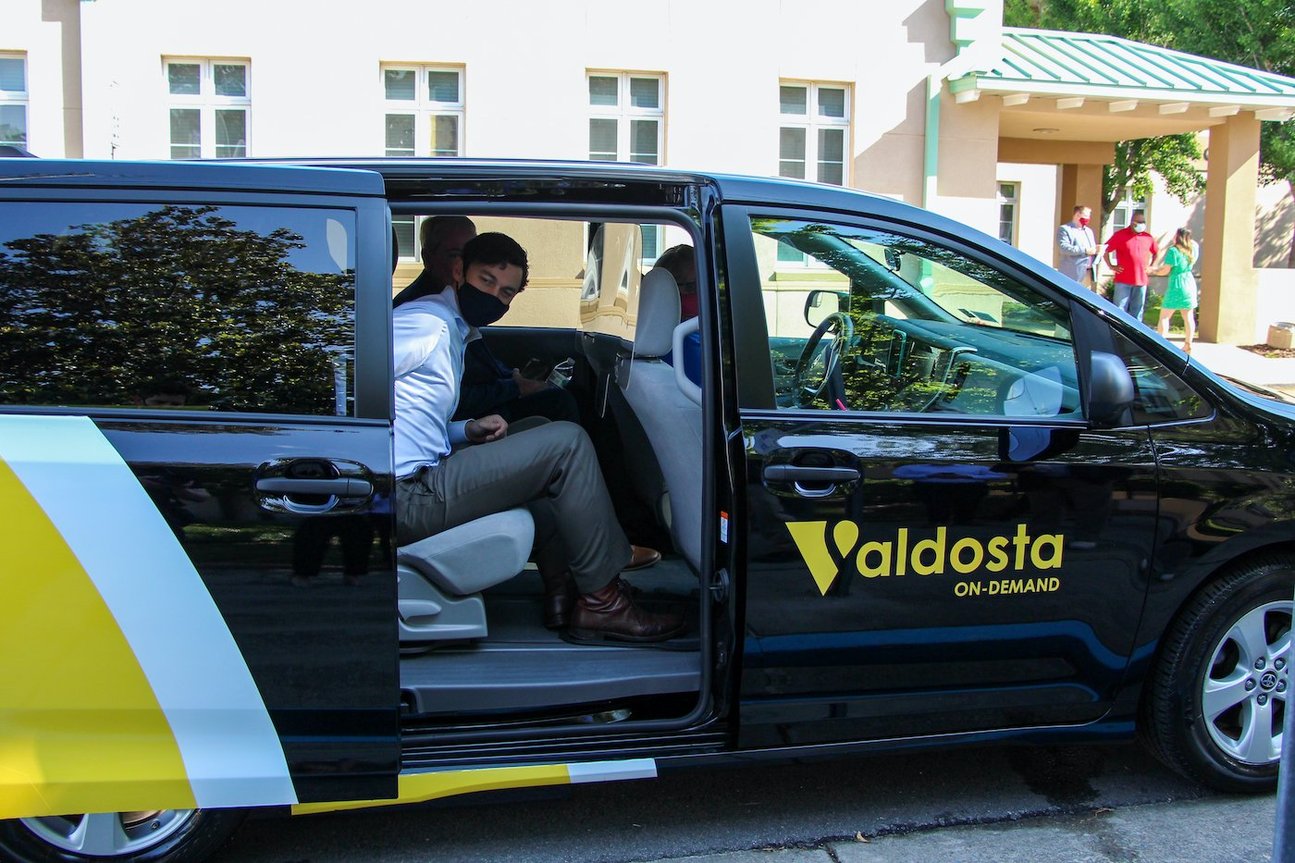 Senator Jon Ossof (D-Ga.) visits Valdosta On-Demand, a microtransit service for which he helped secure federal earmark funding.
Senator Jon Ossof (D-Ga.) visits Valdosta On-Demand, a microtransit service for which he helped secure federal earmark funding.
These earmarks can be a good way to secure funds for microtransit services. The process is highly competitive although over the last few years applications for microtransit funding have had a high success rate. While the timing for earmark applications varies a bit depending on each Congressional office, most deadlines have been in April over the last couple of years.
Federal programs that cover local match
Any community receiving federal funds will need to find a local match to fully finance their project. While most communities find their local match in their local or state budgets, there are some federal programs that provide funding that can serve as a local match or source of additional funding. The FTA outlines these programs in an FAQ. They include transportation assistance programs from the Older Americans Act and Temporary Assistance for Needy Families (TANF).
How state and regional funding comes into play
As explained above, state and regional entities play a significant role in deciding how some federal formula funds are distributed. For example, both the CMAQ and CRP formula streams flow through MPOs and State DOTs. In addition, many states fund transit themselves, including several that have recently boosted funding through budget measures or legislative packages. For example, the State of Minnesota recently passed a transportation funding package which includes fees on delivery services in order to fund transportation projects, including transit.
State funding, much like federal funding, can come in the form of formula funds or competitive grants. Some states, like Florida, also offer a legislatively directed spending process similar to federal earmarks.
 Transit spending per capita varies considerably state by state. Chart courtesy of Transportation for America.
Transit spending per capita varies considerably state by state. Chart courtesy of Transportation for America.
State formula funds
At least 34 states offer formula-based funding streams for transit. These streams vary in funding amounts, mechanisms of distribution, and eligible uses. Some examples include:
- Michigan’s Local Bus Operating Assistance program provides operating funds for 81 transit agencies across the state on a formula basis.
- New York’s Statewide Mass Transportation Operating Assistance (STOA) offers cities operating assistance for transit services based on the amount of service provided.
- Washington’s Rural Mobility and Paratransit Special Needs program distributes funds for capital and operating expenses for rural and paratransit services in specific areas.
As with federal formula funds, state formula streams have advantages and disadvantages compared to competitive programs. Transit operators should consult with their state DOT to access formula funds for microtransit.
State competitive grants
Several states offer competitive transportation grants which can be used to fund microtransit services, including:
California’s Cap-and-Trade auction proceeds fund a number of programs that provide grants for innovative, sustainable, and equitable transit including:
-
- The Transit and Intercity Rail Capital Program (TIRCP) is a large transit program which provides billions of dollars annually from California’s Greenhouse Gas Reduction Fund to support transit projects. The program also provides grants to microtransit services, including both capital and operating support. In 2022, the City of Cupertino secured a grant of $8.5 million for microtransit services.
- $17M in grants for Clean Mobility Options, which provides vouchers for low and zero emission mobility projects, including microtransit. The City of Richmond, California received $1m in CMO vouchers to support a microtransit deployment.
- $22M for the Sustainable Transportation Equity Project (STEP) from the California Air Resources Board (CARB) and $146M in funding for the Low Carbon Transit Operations Program (LCTOP) and the State of Good Repair Grants (SGR) from CalTrans.
- New York State Gov. Kathy Hochul has made microtransit investment a top state transportation priority, with two new grant programs providing important funding resources:
- The Innovative Mobility Initiative (IMI) is a New York State DOT program that provides nearly $25M over 5 years to transit agencies and local governments to fund on-demand mobility services, including to cover local match for federal programs. This initiative uses a combination of state dollars (passed by the Legislature in the 2023 state budget) and flexible federal dollars from the Carbon Reduction Program, an important model that other states could consider. Via-powered services with the Central New York Regional Transportation Authority (Centro) and Suffolk County are using IMI funds for new and expanded microtransit services.
- The New York State Energy Research and Development Authority (NYSERDA)’s $32 million Clean Mobility Program will be accepting grant applications later this year from counties, municipalities, and transit agencies for zero-emission shared mobility services, including microtransit, that solve local transportation needs and help reduce emissions across the state, including in underserved communities. Numerous Round 1 grant winners are pursuing microtransit services, including several in Westchester County, Long Island, and in Western New York.
- Connecticut’s Department of Transportation recently launched their nearly $20 million Microtransit Pilot Program to fund nine transit agencies and municipalities for two-year microtransit pilot programs, including in Stamford and New Haven, which both launched new partnerships with Via in 2025. While the program is currently funded with federal funds, CTDOT is exploring long-term funding solutions for the popular program.
State earmarks
Several state legislatures feature legislatively directed spending processes similar to Congress’s Earmark process. These programs can often go by several different names (including budget line items, walking around money, member items, and discretionary spending) and may have formal or informal processes for agencies or municipalities to use in pursuit of a state earmark. Regardless of their form, these earmarks require similar support from local legislators and are highly competitive like their federal cousins. New Jersey has been an early adopter of using state earmarks to fund microtransit services, including for operations in the City of Camden and in Passaic County.
Regional funding
Some MPOs offer their own grant programs, sometimes by reprogramming federal funds. For example, the Boston Region MPO offers the Community Connections Funding Program , which funds transit operating expenses using federal CMAQ funding. There are hundreds of regional bodies across the United States; transit operators should contract their local MPO or COG to understand what funding is available. In particular, we suggest asking about the new Carbon Reduction Program funding which every MPO across the country will receive (pending approval from the Trump Administration).
Getting local: funding microtransit with ballot measures, partnerships, and congestion pricing
Local funding accounts for the majority of transportation funding in the United States — a whopping 62.3%. Local sources include transit fares, local government budgets, ballot measures, and local partnerships. As local funding sources are constantly in flux, microtransit is an attractive option for many cities and transit agencies because it’s so flexible — it can be scaled up and down to meet demand and resource constraints. Below are a few creative ways to use or raise local funds.
Ballot initiatives and local option taxes
Transit ballot initiatives provide opportunities for local communities to raise dedicated funding for transportation through voter-approved sales or property tax increases. In 2024, voters across the US approved over $25B in transit projects through local and state ballot initiatives.
Increasingly, ballot measures are incorporating funding for microtransit projects. For example, in 2024, voters in Columbus, Ohio approved an $8B ballot initiative for LinkUS, the region’s mobility plan managed through COTA. The plan includes 8 new on-demand transit zones (COTA Plus) in addition to two new Bus Rapid Transit lines and 500 miles of new sidewalks, bikeways and trails.
In 2016, LA County approved Measure M which created a permanent half-cent sales tax dedicated to public transit, raising nearly $900M in transit funding each year. The Visionary Seed Fund used $20M of Measure M funding each year for projects that test and assess ridership growth strategies. In 2024, communities in West Covina and Torrance were awarded $1M in seed funding for microtransit programs.
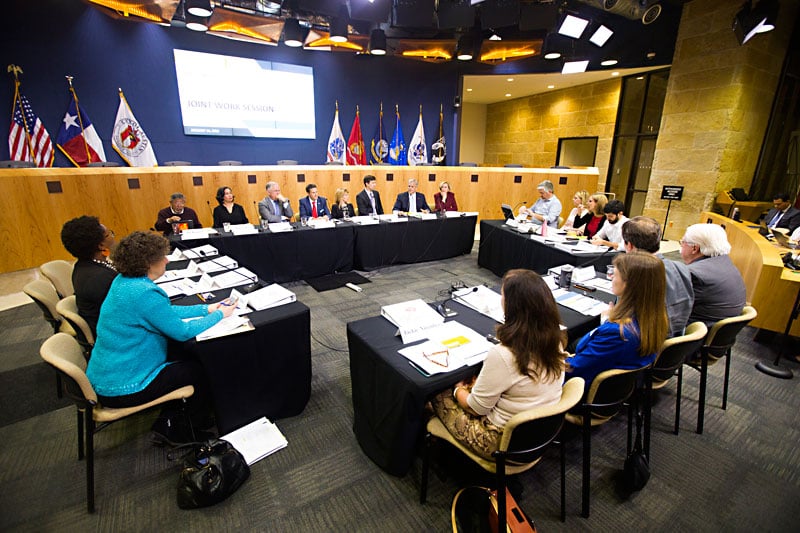
The Austin City Council meets to discuss Project Connect with CapMetro leaders. Photo courtesy of the Austin Chronicle.
Local partnerships
Some local leaders have explored creative alternatives to tax revenues in order to fund their transportation services, and have partnered with key stakeholders in their community — from corporations to foundations to universities — to come together to solve transportation issues.
For example, in 2024, the Mobile Chamber of Commerce launched an on-demand transit pilot focused on workforce transportation. In other communities that have launched on-demand services, Via is working with our local partners to determine which employers benefit the most from the service so that we can encourage them to support the service financially. In Palo Alto, the Stanford Research Park, consisting of Stanford University and businesses in the area, contributes significantly to the city’s microtransit partnership with Via. In Memphis, the Groove On-Demand service is funded through the Downtown Memphis Commission, a business improvement district which collects funds from commercial properties.
Congestion pricing, TNC fees, and tolling
Some state, regional, and local governments are raising funds for public transit, including microtransit, in other ways. When New York State passed its congestion pricing plan for New York City (finally implemented in 2025, though it's under scrutiny from the Trump Administration) it committed to spend some of the revenue from existing TNC and taxi congestion fees on first/last mile improvements in the outer boroughs. So far those revenues have been used for bridge toll and commuter rail discounts, although future funds may still be used for these promised first/last mile investments. Additionally, New York State committed specific dollars from NYSERDA’s Clean Mobility Program to be invested in the outer boroughs as part of the congestion pricing mitigation plan. Whatever the funding source, microtransit deployments can be part of these mitigation solutions—indeed, the upcoming federal Congestion Relief Program explicitly includes on-demand microtransit as an eligible project type to reduce congestion.
Advertising
Most transit agencies are familiar with advertising on buses or trains as a way to generate additional revenue and defray operating costs. Similar opportunities are available for on-demand transit services, whether outside the vehicle (digital “toppers” similar to those found on taxis, vehicle wraps) or inside (ads displayed on in-vehicle screens, or in the app the rider uses to request a ride). Cities from Arlington to Jersey City use advertising to support the long-term success of their microtransit services.
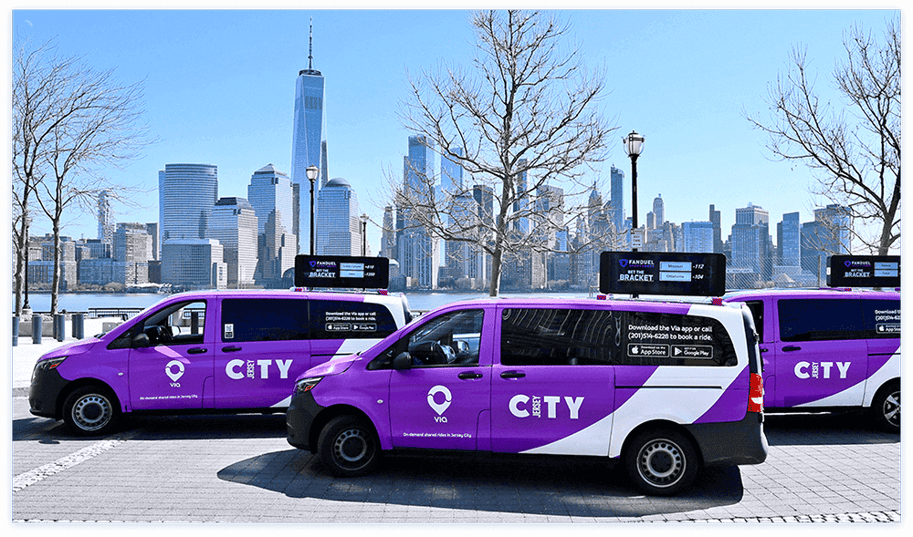 Vehicles in the Via-powered Jersey City microtransit service with toppers displaying digital ads.
Vehicles in the Via-powered Jersey City microtransit service with toppers displaying digital ads.
Next Steps
Have other funding ideas we may have missed, or looking for any help with securing funding of your own? Let's talk!

State and Local Public Policy @ Via

